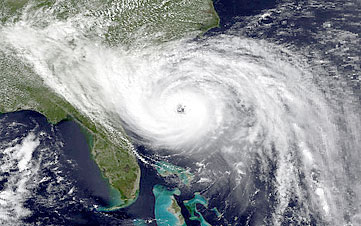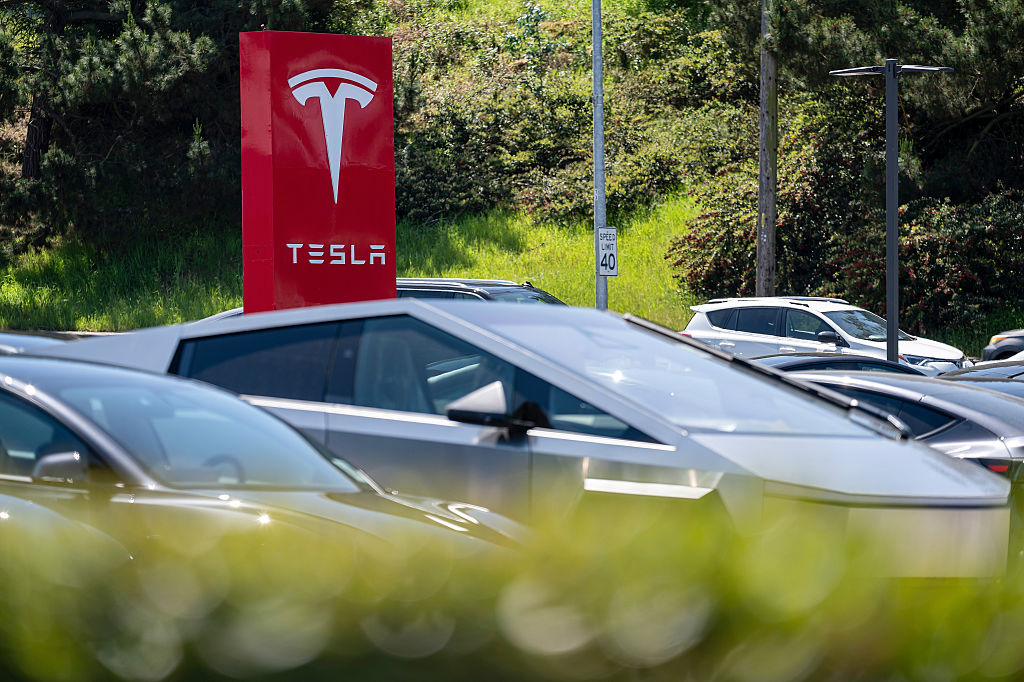Insurance Stocks Do Just Fine Amid Harsh Weather
Strange as it sounds, heat waves and car accidents might be good for your portfolio.


Last year, the U.S. set a record for hugely expensive weather- and climate-related disasters: a hurricane in Florida, floods in California, a wildfire in Hawaii, a winter storm in the Northeast, tornados all over. The nation was hit by 28 catastrophes with total damages of more than $1 billion. Over the past seven years, reports the National Oceanic and Atmospheric Administration, 137 separate billion-dollar disasters, including five Category 4 or 5 hurricanes, have caused more than $1 trillion in devastation.
“It is important to keep in mind that these estimates do not reflect the total cost of U.S. weather and climate disasters, only those associated with events [with] more than $1 billion in damages,” said a NOAA report earlier this year. “That means they are a conservative estimate of how much extreme weather costs the United States each year” (boldface NOAA’s).
The property and casualty insurance industry picks up much of the tab for these catastrophes. As a result, the sector recorded a total of $50 billion in underwriting losses — that is, the gap between claims and premiums — in 2022 and 2023.

Sign up for Kiplinger’s Free E-Newsletters
Profit and prosper with the best of expert advice on investing, taxes, retirement, personal finance and more - straight to your e-mail.
Profit and prosper with the best of expert advice - straight to your e-mail.
P&C companies also pick up the tab for traffic accidents. The single largest share of premiums in the industry — one-third — is paid by owners of private passenger vehicles. Fatal accidents have leveled off lately, but the figure is still very high — more than 40,000 deaths per year — and about 25% higher than it was 10 years ago. Nearly 4 million crashes per year cause property damage.
In an era of safety features including air bags, blind-spot sensors, rearview cameras and automatic braking, why are there so many accidents? Americans are distracted by smartphones, prefer heavy SUVs that cause more damage and make it harder to see pedestrians, and use their car to vent anger. Insurers have to contend with the persistence of speeding, drunk driving and stupidity (half the people killed on the road weren’t wearing seat belts).
Insurer stocks. So how are P&C insurers’ stocks doing? One gauge is iShares U.S. Insurance (IAK), the largest exchange-traded fund for the sector. Over the 12 months ending May 31, the fund has returned 44.0%, more than 15 points better than the S&P 500 index, the large-cap benchmark. In other words, while America is burning or being blown away, while drunk and enraged drivers are causing millions of accidents, insurance companies are doing just fine, thank you.
The largest P&C insurer in the world, State Farm, is owned by its policyholders; so is Liberty Mutual, ranked sixth. The third largest is a group of firms, including GEICO, under the umbrella of Warren Buffett’s Berkshire Hathaway (BRK-A). That leaves four U.S.-based, listed P&C insurers among the top 20 in the world.
Progressive (PGR), the biggest listed P&C insurer in terms of both premium revenue and market capitalization (shares outstanding times price), has returned an annual average of 22.6% over the past five years — more than six percentage points better than the S&P 500. Allstate (ALL), the second biggest, has returned 58.6% over the past 12 months. The next-largest, American International Group (AIG), which has a substantial life insurance business, has returned 51.9% in the past year; Travelers Companies (TRV), with a focus on midsize commercial businesses, is up 29.8%.
How can these insurers pay enormous claims and still see their stocks rise? They are in a great business. Customers pay monthly premiums, and the company doesn’t have to cough up any money unless there’s a valid claim. As Buffett said in his 2022 annual report, this is “money we hold and can invest but that does not belong to us.” The money — in effect, an interest-free loan — is called a float, and for Berkshire it amounted at the end of 2023 to $167 billion.
A key metric for insurers is the combined ratio, the annual sum of incurred losses and expenses divided by premiums. The lower the combined ratio, the better. In 2023, because of all those disaster claims, it was 103% — that is, companies paid out more than they took in. But the combined ratio does not include investment earnings, so even if an insurer’s combined ratio exceeds 100%, the firm can still be profitable.
Insurers have something else going for them: Most of their customers have to buy their products. States require drivers to have auto insurance. Mortgage lenders require homeowners to insure their property. Landlords demand renters carry insurance. With litigation a growth business, any company without liability insurance is asking for trouble.
The downside is that insurance is such a good business that competitors abound. Also, in recent years, higher inflation has increased the cost of replacing damaged automobiles and houses. But inflation has been accompanied by higher interest rates, which allow insurers to earn more when they invest their float in safe vehicles like Treasury bonds.
What about all those disasters? As risks rise, insurance companies respond by raising their rates. Auto insurance premiums have jumped 22% in the past 12 months. Homeowners’ insurance has increased by 23% — and in some states by much more. In Louisiana, where flood risk is high, rates are up 63%; in Arizona (wildfires), they’re up 40%.
State regulators can limit rates, but if they are too restrictive, companies will simply leave. In California, State Farm, Allstate and other insurers announced this year that they won’t issue new policies for thousands of homeowners because of wildfire risk. The situation is so bad in Florida that 11 insurance companies have been liquidated since 2017, and dozens have left the state.
In a world in which catastrophic events are increasing, the real danger for insurance firms is underwriting — evaluating a risk and properly pricing it. Every large insurer is investing in artificial intelligence, which can analyze vast amounts of claims data and make weather predictions. Expect AI to help the industry become even more profitable.
Where to invest? I would stick with the big companies like Allstate, AIG and Travelers. My favorites are Progressive and Chubb (CB), which is headquartered in Switzerland — though Chubb focuses on high-income U.S. customers. Buffett has been buying the stock since last year and now owns about 7% of the firm, whose $110 billion market cap is slightly behind Progressive’s. Chubb’s price-earnings ratio, based estimated earnings for 2025, is just 12.
As for funds: The iShares ETF is weighted heavily toward P&C companies, with 28% of its assets in Progressive and Chubb, but it also owns life insurers, which I find less attractive. Another good choice is Invesco KBW Property & Casualty Insurance (KBWP), an ETF with an expense ratio of 0.35%. Its portfolio is less top-heavy. It includes some excellent smaller P&C carriers, such as Everest Group (EG), which has a large re-insurance segment (backing up other insurers), and The Hartford Financial Services Group (HIG), with strong commercial and homeowners lines.
For most Americans, insurance companies have been a curse the past few years, as they have crushed household budgets with higher premiums. But if you buy their shares, you have a chance to turn insurers into a blessing.
James K. Glassman chairs Glassman Advisory, a public-affairs consulting firm. He does not write about his clients. His most recent book is Safety Net: The Strategy for De-Risking Your Investments in a Time of Turbulence. He owns none of the investments mentioned here. You can reach him at JKGlassman@gmail.com.
Note: This item first appeared in Kiplinger Personal Finance Magazine, a monthly, trustworthy source of advice and guidance. Subscribe to help you make more money and keep more of the money you make here.
Related Content
Get Kiplinger Today newsletter — free
Profit and prosper with the best of Kiplinger's advice on investing, taxes, retirement, personal finance and much more. Delivered daily. Enter your email in the box and click Sign Me Up.

-
 Married? Five Ways to Ensure Your Estate Plans Work in Tandem
Married? Five Ways to Ensure Your Estate Plans Work in TandemGetting on the same page now means fewer potential problems when it counts.
By Kiplinger Advisor Collective
-
 12 Investments No Retiree Should Make
12 Investments No Retiree Should MakeIn retirement, when it's wise to take fewer risks with your nest egg, some investments are just nuts.
By David Rodeck
-
 12 Investments No Retiree Should Make
12 Investments No Retiree Should MakeIn retirement, when it's wise to take fewer risks with your nest egg, some investments are just nuts.
By David Rodeck
-
 Before You Invest Like a Politician, Consider This Dilemma
Before You Invest Like a Politician, Consider This DilemmaAs apps that track congressional stock trading become more popular, investors need to take into consideration some caveats.
By Ryan K. Snover, Investment Adviser Representative
-
 How to Put Together Your Personal Net Worth Statement
How to Put Together Your Personal Net Worth StatementNow that tax season is over for most of us, it's the perfect time to organize your assets and liabilities to assess your financial wellness.
By Denise McClain, JD, CPA
-
 Stock Market Today: Trump Retreats, Markets Rejoice
Stock Market Today: Trump Retreats, Markets RejoiceStocks rally, yields soften, the dollar rises, and even beaten-down names enjoy the wages of potential trade peace.
By David Dittman
-
 Tesla Stock Pops as Elon Musk Promises DOGE Draw Back
Tesla Stock Pops as Elon Musk Promises DOGE Draw BackTesla reported a sharp drop in first-quarter earnings and sales, as the EV maker suffered a backlash to its CEO's political ambitions.
By Karee Venema
-
 Bouncing Back: New Tunes for Millennials Trying to Make It
Bouncing Back: New Tunes for Millennials Trying to Make ItAdele's mournful melodies kick off this generation's financial playlist, but with the right plan, Millennials can finish strong.
By Alvina Lo
-
 Early-Stage Startup Deals: How Do Convertible Notes Work?
Early-Stage Startup Deals: How Do Convertible Notes Work?Some angel investors support early startups by providing a loan in exchange for a convertible note, which includes annual interest and a maturity date.
By Murat Abdrakhmanov
-
 Stock Market Today: Stocks Soar on China Trade Talk Hopes
Stock Market Today: Stocks Soar on China Trade Talk HopesTreasury Secretary Bessent said current U.S.-China trade relations are unsustainable and signaled hopes for negotiations.
By Karee Venema